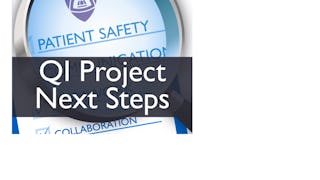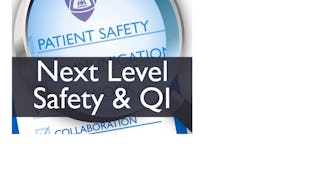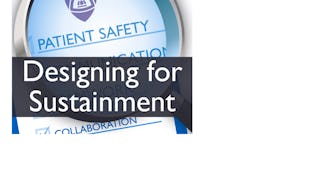In this course, you will be able develop a systems view for patient safety and quality improvement in healthcare. By then end of this course, you will be able to: 1) Describe a minimum of four key events in the history of patient safety and quality improvement, 2) define the key characteristics of high reliability organizations, and 3) explain the benefits of having strategies for both proactive and reactive systems thinking.



Patient Safety and Quality Improvement: Developing a Systems View (Patient Safety I)
This course is part of Patient Safety Specialization

Instructor: Melinda Sawyer
38,011 already enrolled
Included with
(1,555 reviews)
Recommended experience
What you'll learn
Describe a minimum of four key events in the history of patient safety and quality improvement.
Define the key characteristics of high reliability organizations.
Explain the benefits of having strategies for both proactive and reactive systems thinking.
Skills you'll gain
Details to know

Add to your LinkedIn profile
4 assignments
See how employees at top companies are mastering in-demand skills

Build your subject-matter expertise
- Learn new concepts from industry experts
- Gain a foundational understanding of a subject or tool
- Develop job-relevant skills with hands-on projects
- Earn a shareable career certificate

There are 4 modules in this course
In this module, you will review the history of patient safety and quality improvement in healthcare. You will start with defining the scope of the problem of preventable harm in healthcare which leads into the history of the work that has been done to date that has helped to define, measure and improve preventable harm. You review three landmark reports to ensure you have a deep understanding of this work. At the end of this module, you will be able to: 1) identify a minimum of four key events in the history of patient safety an quality improvement, 2) describe the key characteristics of each of the three landmark patient safety publications and 3) summarize the impact of preventable harm on patients, communities and society.
What's included
7 videos5 readings1 assignment
In this module, you will be reviewing several key terms and tools that are used in patient safety and quality improvement. This will allow you to begin to develop the common language used among patient safety and quality improvement experts and practitioners. By the end of this module you will be able to: 1) differentiate between the terms harm, hazard, error and risk within a patient safety and quality improvement framework, 2) describe how quality and safety overlap and how they are different and 3) differentiate between root cause analysis and a failure mode and effects analysis.
What's included
11 videos1 assignment
In this module, you will learn the fundamental principles of high reliability organizing. At the end of this lesson, you will also be able to: 1) describe the socio-cultural characteristics of high reliability organizations (HROs), 2) compare and contrast healthcare with high reliability organizations and 3) identify three improvement tools for high reliability organizing.
What's included
7 videos1 assignment
In this module, you will learn the basics of systems thinking and then apply these to a healthcare setting. At the end of this module, you will be able to 1) explain the basic components of a system, 2) differentiate first order problem solving and second order problem solving, 3) explain the benefits of having strategies for both proactive and reactive systems thinking.
What's included
9 videos1 assignment
Earn a career certificate
Add this credential to your LinkedIn profile, resume, or CV. Share it on social media and in your performance review.
Instructor

Offered by
Explore more from Healthcare Management
 Status: Free Trial
Status: Free TrialJohns Hopkins University
 Status: Free Trial
Status: Free TrialJohns Hopkins University
 Status: Free Trial
Status: Free TrialJohns Hopkins University
 Status: Free Trial
Status: Free TrialJohns Hopkins University
Why people choose Coursera for their career




Learner reviews
1,555 reviews
- 5 stars
84.75%
- 4 stars
13.31%
- 3 stars
1.22%
- 2 stars
0.25%
- 1 star
0.45%
Showing 3 of 1555
Reviewed on Feb 14, 2019
Indeed the facilitators have really done well in delivery of the content, I will organize all my friends to enroll in the course. You are indeed doing a wonderful job. Kudos to you guys.
Reviewed on Jul 23, 2020
it was a great experience to learn under the supervision of John Hopkins university. the teacher/ instructor Bob was awesome in delivering the content.
Reviewed on Feb 25, 2022
It´s a very practical and interesting course. Very helpful and clear enough to implement the concepts and strength quality and patient safety culture

Open new doors with Coursera Plus
Unlimited access to 10,000+ world-class courses, hands-on projects, and job-ready certificate programs - all included in your subscription
Advance your career with an online degree
Earn a degree from world-class universities - 100% online
Join over 3,400 global companies that choose Coursera for Business
Upskill your employees to excel in the digital economy
Frequently asked questions
To access the course materials, assignments and to earn a Certificate, you will need to purchase the Certificate experience when you enroll in a course. You can try a Free Trial instead, or apply for Financial Aid. The course may offer 'Full Course, No Certificate' instead. This option lets you see all course materials, submit required assessments, and get a final grade. This also means that you will not be able to purchase a Certificate experience.
When you enroll in the course, you get access to all of the courses in the Specialization, and you earn a certificate when you complete the work. Your electronic Certificate will be added to your Accomplishments page - from there, you can print your Certificate or add it to your LinkedIn profile.
Yes. In select learning programs, you can apply for financial aid or a scholarship if you can’t afford the enrollment fee. If fin aid or scholarship is available for your learning program selection, you’ll find a link to apply on the description page.
More questions
Financial aid available,

